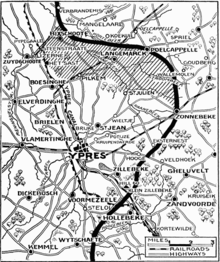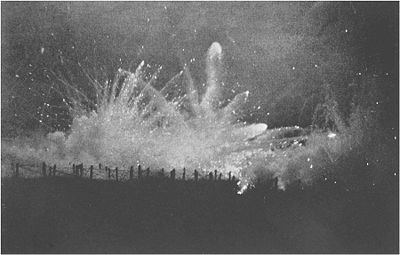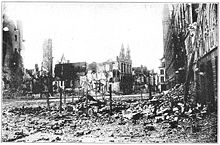Second Battle of Ypres - Picture
More about World War 1

|
|
Second Battle of Ypres
Date: Date
Thursday 22 April - 25 May 1915
Location
Ypres, Belgium
Result
Stalemate
Date: Thursday 22 April - 25 May 1915
Ypres, Belgium
Result: Stalemate
Belligerents:
: France
Army of Africa
United Kingdom
Canada
British India
Commanders and leaders:
: Horace Smith-Dorrien
Arthur Currie
Henri Gabriel Putz
A.-L.-T. de Ceuninck
Theophile Figeys
Strength:
: 8 infantry divisions
Casualties and losses:
: 70,000 dead, wounded, or missing
Army of Africa
United Kingdom
Canada
British India
The Second Battle of Ypres was the first time Germany used poison gas on a large scale on the Western Front in the First World War and the first time a former colonial force (Canadians) pushed back a major European power (Germans) on European soil, which occurred in the battle of St. Julien-Kitcheners' Wood.
Overview
The Second Battle of Ypres consisted of four separate engagements:
The Battle of Gravenstafel: Thursday 22 April - Friday 23 April 1915
The Battle of Saint Julien: Saturday 24 April - 4 May 1915.
The Battle of Frezenberg: 8-13 May 1915
The Battle of Bellewaarde: 24-25 May 1915
The scene of the battles was the Ypres salient on the Western Front, where the Allied line which followed the canal bulged eastward around the town of Ypres, Belgium. North of the salient were the Belgians; covering the northern part of the salient itself were two French divisions (one Metropolitan and one Algerian) The eastern part of the salient was defended by one Canadian division and two UK divisions.
In total during the battles, the British Commonwealth forces were the II and V Corps of the Second Army made up of the 1st, 2nd and 3rd Cavalry divisions, and the 4th, 27th, 28th, 50th, Lahore and 1st Canadian Divisions.
Battle of Gravenstafel (22-23 April 1915)
50°53′28″N 2°58′44″E / 50.891°N 2.979°E / 50.891; 2.979 Today this tiny hamlet is named Gravenstafel.
Gas attack on Gravenstafel
At around 5:00 pm on April 22, 1915, the German Army released one hundred and sixty eight tons of chlorine gas over a 6.5 km (4 mile) front on the part of the line held by French Territorial and colonial Moroccan and Algerian troops of the French 45th and 78th divisions. While this is often recognized as the first use of chemical warfare, poison gases were used at several earlier battles, including the Battle of Bolimov three months earlier.
The attack involved a massive logistical effort, as German troops hauled 5730 cylinders of chlorine gas, weighing 90 pounds (41 kg) each, to the front by hand. The German soldiers also opened the cylinders by hand, relying on the prevailing winds to carry the gas towards enemy lines. Because of this method of dispersal, a large number of German soldiers were injured or killed in the process of carrying out the attack.
Approximately 6,000 French and colonial troops died within ten minutes at Ypres, primarily from asphyxiation and subsequent tissue damage in the lungs. Many more were blinded. Chlorine gas forms hydrochloric (muriatic) acid when combined with water, destroying moist tissues such as lungs and eyes. The chlorine gas, being denser than air, quickly filled the trenches, forcing the troops to climb out into heavy enemy fire.
With the survivors abandoning their positions en masse, a 4-mile (6.4 km) gap was left in the front line. However, the German High Command had not foreseen the effectiveness of their new weapon, and so had not put any reserves ready in the area. German troops started to enter the gap at 5:00PM in some numbers, but with the coming of darkness and the lack of follow up troops the German forces did not exploit the gap, and Canadian troops were able to put in a hasty defence by urinating into cloths and putting them to their faces to counter the effects of the gas. Canadians held that part of the line against further attacks until 3 May 1915 at a cost of 6000 wounded or dead. Casualties were especially heavy for the 13th Battalion of the CEF, which was enveloped on three sides and over-extended by the demands of securing its left flank once the Algerian Division had broken.
One thousand of these "original" troops were killed and 4,975 were wounded from an initial strength of 10,000.
At Kitcheners' Wood, the 10th Battalion of the 2nd Canadian Brigade was ordered to counter-attack into the gap created by the gas attack. They formed up after 11:00pm on the night of 22 April with the 16th Battalion (Canadian Scottish) of the 3rd Brigade arriving as they were forming, tasked to support the advance. Both battalions stepped off with over 800 men, formed up in waves of two companies each, at 11:46 pm. Without prior reconnaissance, the battalions ran into obstacles half way to the objective and drew heavy automatic weapons fire from the Wood, prompting an impromptu bayonet charge. Their attack cleared the former oak plantation of Germans at the cost of 75 percent casualties.
The Canadian actions during the Battle of Gravenstafel are commemorated with the Saint Julien Memorial in the village of Saint Julien.
Battle of St Julien (24 April - 5 May)
50°53′24″N 2°56′13″E / 50.890°N 2.937°E / 50.890; 2.937 Today this is known as Saint Juliaan.

Picture - Positions on about 30 April, before the British pullback
The village of St. Julien had been comfortably in the rear of the 1st Canadian Division until the poison gas attack of 22 April, whereupon it became the front line. Some of the first fighting in the village involved a hasty stop, which included the stand of Lance Corporal Frederick Fisher of the 13th Battalion CEF's machine-gun detachment; who twice went out with a handful of men and a Colt Machine-gun and prevented advancing German troops from passing through St. Julien into the rear of the Canadian front line. Fisher was awarded the VC for his actions on the 22nd, but was killed when he attempted to repeat his actions on the 23; this was the first of 70 Canadian VCs awarded in the First World War.
On the morning of 24 April 1915 the Germans released another cloud of chlorine gas, this time directly towards the re-formed Canadian lines just west of the village of St. Julien. On seeing the approach of the greenish-grey gas cloud, word was passed among the Canadian troops to urinate on their handkerchiefs and place these over their noses and mouths.
![World War 1 Picture - Francis Alexander Caron Scrimger, V.C., M.D. Capt. Scrimger, with the 2nd Canadian Field Ambulance, may have passed the order to use urine to counteract the gas, but there is some doubt (see note 10). Captain Scrimger received a Victoria Cross for other actions on 25 April.[17][18]](./images/1-images52211/220px-FAC_Scrimger_VC.JPG)
Picture - Francis Alexander Caron Scrimger, V.C., M.D. Capt. Scrimger, with the 2nd Canadian Field Ambulance, may have passed the order to use urine to counteract the gas, but there is some doubt (see note 10). Captain Scrimger received a Victoria Cross for other actions on 25 April.[17][18]
However, the countermeasures were ineffective and the Canadian lines broke as a result of the attack, allowing German troops to take the village.
The following day the York and Durham Brigade units of the Northumberland Division counterattacked failing to secure their objectives but establishing a new line close to the village. The third day the Northumberland Brigade attacked again, briefly taking part of the village but forced back with the loss of more than 1,900 men and 40 officers - two thirds of its strength.
The 2nd Royal Dublin Fusiliers Battalion suffered heavily, incurring hundreds of casualties and with no respite took part in the next two subsidiary battles at Frezenberg and Bellewaarde. On 24 May the battalion was subject to a German chlorine gas attack near Saint Julien and effectively disintegrated as a fighting unit.
Battle of Frezenberg (8-13 May)
50°52′05″N 2°57′00″E / 50.868°N 2.950°E / 50.868; 2.950
The Germans had moved their artillery forward and put three Army corps opposite the 27th and 28th divisions on the Frezenberg ridge. The battle began on May 8 with a bombardment that disrupted the 83rd Brigade holding trenches on the forward side of the ridge but the first and second assaults by German infantry were repelled by the survivors. The third German assault of the morning pushed the defenders back. While the neighbouring 80th Brigade stopped the advance, the 84th Brigade was broken giving a two mile gap in the line. Further advance was stopped through counterattacks and a night move by the 10th Brigade. On the 9th the German attack was across the Menin road against the 27 Division.
On 10 May the Germans released another gas cloud but made little progress. The battle ended after six days of fighting with a German advance of 2000 yards.
Battle of Bellewaarde (24-25 May)
50°50′49″N 2°57′00″E / 50.847°N 2.950°E / 50.847; 2.950

Picture - German barrage on Allied trenches at Ypres. Probably Second Battle of Ypres, 1915
On 24 May the Germans released a gas attack on a 4.5-mile (7.2 km) front. British troops were able to defend against initial German attacks but eventually they were forced to retreat to the north and south. Failed British counterattacks forced a British retreat 1000 yards northwards. Upon the end of the battle the Ypres salient was 3 miles (4.8 km) deep.
Aftermath
By the end of the battle the size of the Ypres Salient had been reduced such that Ypres itself was closer to the line. In time it would be reduced by shelling until virtually nothing would remain standing.
The surprise use of poison gas was not a historical first (poison gas had already been used on the Eastern Front) but did come as a tactical surprise to the Allies. After Second Ypres, both sides developed more sophisticated gas weapons, and countermeasures, and never again was the use of gas either a surprise, nor especially effective. The British quickly developed their own gas attacks using them for the first time at the Battle of Loos in late September. Development of gas protection was instituted and the first examples of the PH helmet issued in July 1915.

Picture - Ruins of Ypres market square.
The Canadian Division was forced to absorb several thousand replacements shortly afterwards, but presented a most favourable image to their allies and the world. Another Canadian division joined the British Expeditionary Force in late 1915, joined eventually by two more in 1916. The battle also blooded many commanders, singling out some for praise, such as brigade commander Arthur Currie, and others for criticism, such as Garnet Hughes.
The inadequacies of training and doctrine in the early CEF was made obvious by the antique tactics used at Kitcheners' Wood and St. Julien, though tactics in the British Colonial armies would be slow to evolve. At Second Ypres, the smallest tactical unit in the infantry was a company; by 1917 it would be the section. The Canadians were employed offensively later in 1915, but not successfully.
A Third Battle of Ypres, more commonly known as the Battle of Passchendaele was fought in the autumn of 1917. The battle was marked by Canadian tactical successes as a result of many innovations in organization, training and tactics in both the infantry and artillery.
Canadian honour
It was during the Second Battle of Ypres that Lieutenant Colonel John McCrae M.D. of Guelph, Ontario, Canada wrote the memorable poem In Flanders Fields in the voice of those who perished in the war. Published in Punch Magazine December 8, 1915, it is still recited today, especially on Remembrance Day and Memorial Day.
First Battle of Ypres
Use of poison gas in World War I
Saint Julien Memorial
Third Battle of Ypres
List of Canadian battles during World War I
...I wish particularly to repudiate any idea of attaching the least blame to the French Division for this unfortunate incident. After all the examples our gallant Allies have shown of dogged and tenacious courage in the many trying situations in which they have been placed throughout the course of this campaign it is quite superfluous for me to dwell on this aspect of the incident, and I would only express my firm conviction that, if any troops in the world had been able to hold their trenches in the face of such a treacherous and altogether unexpected onslaught, the French Division would have stood firm.
...I wish particularly to repudiate any idea of attaching the least blame to the French Division for this unfortunate incident. After all the examples our gallant Allies have shown of dogged and tenacious courage in the many trying situations in which they have been placed throughout the course of this campaign it is quite superfluous for me to dwell on this aspect of the incident, and I would only express my firm conviction that, if any troops in the world had been able to hold their trenches in the face of such a treacherous and altogether unexpected onslaught, the French Division would have stood firm.
Chattaway, F. D. (1908). "The Action of Chlorine upon Urea Whereby a Dichloro Urea is Produced". Proc. Roy. Soc. London. Ser. A 81 (549): 381-388. JSTOR 93011.
Chattaway, F. D. (1916). "Captain F.A.C. Scrimger, V.C.". Can. Med. Assoc. J. 6 (4): 334-336. PMC 1584589. http://www.pubmedcentral.nih.gov/articlerender.fcgi?tool=pmcentrez&artid=1584589.
Cassar, George H. (2010). Hell in Flanders Fields: Canadians at the Second Battle of Ypres. Dundurn Press. ISBN 9781554887286. http://books.google.ca/books?id=m7p4L0fVRBAC&lpg=PA10&dq=Beyond%20courage%3A%20the%20Canadians%20at%20the%20Second%20Battle%20of%20Ypres&pg=PP1#v=onepage&q&f=true.
Howell, W. B. (1938). "Colonel F.A.C. Scrimger, V.C.". Can. Med. Assoc. J. 38 (3): 279-281. PMC 536406. http://www.pubmedcentral.nih.gov/articlerender.fcgi?tool=pmcentrez&artid=536406.
"Legion Magazine online". http://www.legionmagazine.com/features/victoriacross/04-07.asp.
Love, D. (1996). "The Second Battle of Ypres, April 1915". Sabretasche 26 (4). http://www.worldwar1.com/sf2ypres.htm.
Nasmith, G. G. (1917). On the Fringe of the Great Fight. Toronto: McClelland, Goodchild & Stewart. http://www.gutenberg.org/files/19876/19876-h/19876-h.htm.
Scott, F. G. (1922). The Great War as I Saw It. Toronto: Goodchild Publishers. http://www.gutenberg.org/files/19857/19857-h/19857-h.htm#page055.
More aircraft.
Source: WikiPedia